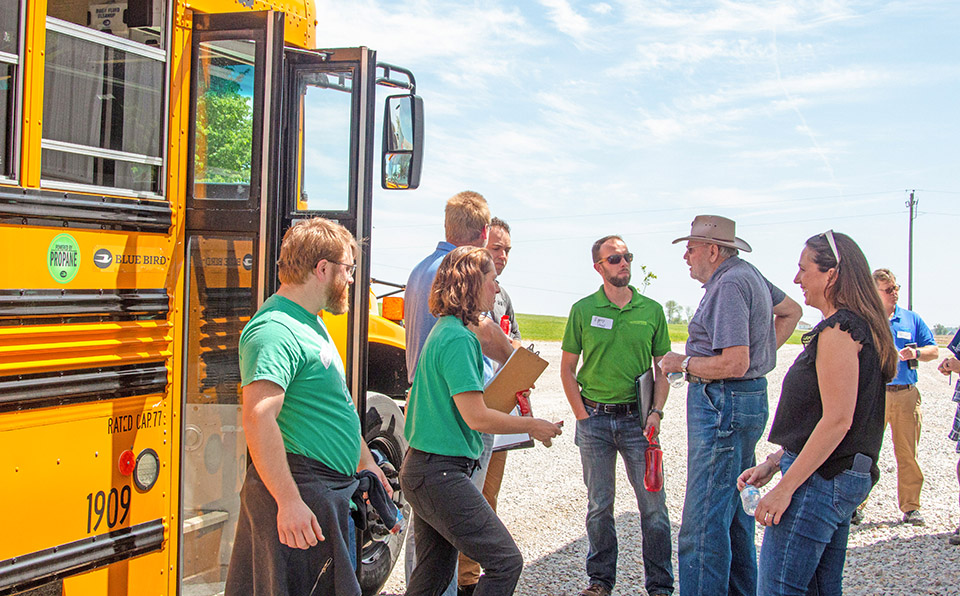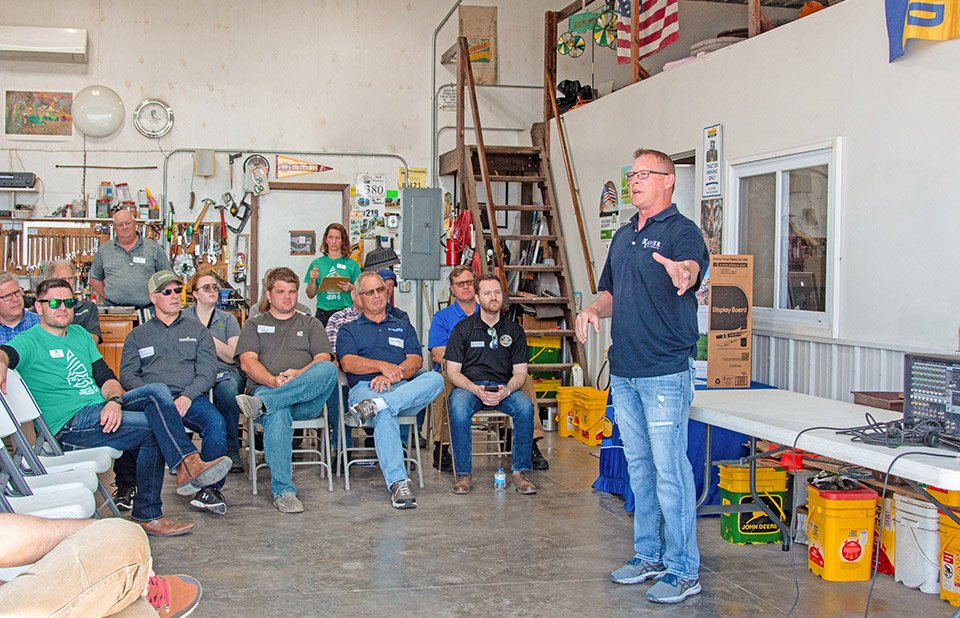
(Photo: Iowa Agriculture Water Alliance)
The next 10 years - and beyond
August 31, 2023 | Jeff Hutton
“Do you want your children to be able to farm?” asks Linn County farmer and Iowa Soybean Association (ISA) member Jim O’Connell. “If we don’t start doing things to help the environment, your sons or daughters may not have that opportunity.”
That’s part of the message that O’Connell and others offer as Iowa continues its quest to continue the progress of the Iowa Nutrient Reduction Strategy (NRS) and improve water quality. After the first 10 years of implementing the NRS, what needs to happen in the future to protect against soil erosion and damage, and improve water quality while simultaneously bettering yields and bolstering a farmer’s bottom line?
More to do
While conservation advancements have been made in the past decade on Iowa farms, more must be done.
“We’ve come a long way, and we have a long way to go,” says Iowa Secretary of Agriculture Mike Naig. “We are proud of our progress, but we are not satisfied. We know there is much more work to do in the years ahead. As we head into the second decade of the nutrient reduction strategy, the pace of this work will continue to accelerate.”
Progress needs to build upon the types of cost-share programs that have proven successful while also embracing working lands conservation to keep farmland productive, he says.
“The advent of markets based on sustainability metrics and credits could be promising if it benefits the farmers making investments in soil health and conservation,” Naig says.
Iowa Agriculture Water Alliance (IAWA) Executive Director Sean McMahon agrees.
“The first decade of the Iowa Nutrient Reduction Strategy implementation saw tremendous progress in scaling up conservation practices to improve water quality,” he says. “Iowa is already No. 1 in the nation in numerous conservation practices, including conservation tillage, nutrient treatment wetlands, pollinator habitat, saturated buffers, bioreactors, grass waterways, terraces and buffers.”
McMahon says there are plenty of reasons for optimism. He looks forward to the addition of conservation agronomists to leverage farmers’ most trusted advisors to deliver more conservation through the ag retail sector. These agronomists can help farmers implement globally leading nitrogen recommendations coming out of Iowa State University’s (ISU) Iowa Nitrogen Initiative in the next few years. There’s also the record levels of federal funding for conservation practices and the increasing number of opportunities for farmers and landowners to receive market payments for ecosystem services.

“As we enter the next decade of implementing the strategy, Iowa will benefit from nearly 20 different Partnerships for Climate Smart Commodities projects,” says McMahon, noting that IAWA helped secure $80 million in funding for the Horizon II project, which is being led by Roeslein Alternative Energy (RAE), with support from ISU, IAWA, ISA and other partners.
“This project will pay farmers and landowners to grow native prairie plants and cover crops, which will be combined with manure in anaerobic digesters that will produce clean, renewable natural gas,” he says. “RAE’s vision is to leverage this project to scale up 30 million acres of restored prairie and drive adoption of another 100 million acres of cover crops throughout the Mississippi River Basin. Accomplishing these goals would be transformational for improving water quality, restoring soil health, reducing soil erosion, creating wildlife habitat and reducing flood risk to downstream communities.”
On the farm
At the forefront of the Iowa NRS are the conservation practices underway by Iowa’s farmers.
O’Connell and fellow ISA farmer-member Dan Voss of Benton County have been instrumental in this effort by making changes on their farms. Both were part of the field days highlighting the NRS’ 10th anniversary in May. Voss and O’Connell have put numerous conservation efforts into practice that have directly and positively impacted the Cedar River Watershed. Their work is part of the Cedar River Source Water Partnership (CRSWP) designed to help protect water resources for the City of Cedar Rapids.
“In our area, the adaptation of these practices is proof that conservation has caught on,” says Voss, who has implemented a variety of conservation projects on his farm over the past 10 years.
The same can be said for O’Connell.
“It was a no-brainer to me,” says O’Connell, who recently developed a wetland on his land to improve water quality. “It not only helps me, but it helps everyone. I want clean water, too.”
Wetlands, cover crops, bioreactors, saturated buffers and other edge-of-field practices are critical, Voss and O’Connell say, because protecting land and water is critical.
Both agree that farmers, understandably, might be hesitant to adopt these practices — the unknown and any kind of change can be scary.
“I think many farmers are unaware of what the nutrient reduction strategy is,” Voss says, hoping he and others can bring more awareness to the issue.
O’Connell says he’s on board with changes on the farm because it’s imperative to protect soil and water resources.
“I think the incentives will help tremendously with continued funding for the next several years,” he says. “I’m also a big believer in education.” He hopes his efforts bring more awareness of the Iowa Nutrient Reduction Strategy.
“We need to break the cycle and say that it’s OK to no-till, strip-till and not work the ground up,” O’Connell says. “We need to change hearts and minds. Many farmers are intimidated by conservation because they don’t know where to start.”
While O’Connell and Voss want elected leaders at the local, state and federal levels to understand the value of these conservation efforts, they don’t want to see mandates.

Partnerships further efforts
Both agree that voluntary efforts by more producers, along with continued partnerships between the ag sector, retailers, businesses, private entities and government, is key, not unlike the CRSWP.
“Look at Cedar Rapids,” Voss says. “They want quality water for their production facilities and residents. The public wants it.”
Events like the ones hosted as part of IAWA’s recognition of the Defining Decade help farmers get a firsthand look at the efforts in the state to promote conservation.
“We’re still learning,” O’Connell says. “It’s trial and error every year. It’s about taking baby steps.”
In the end, the two men agree collaborative efforts over the next decade will be essential to meeting the goals outlined in the strategy.
“We all need to do something to work toward that goal,” Voss says. “It pains my heart to drive down the road and see planting right next to a stream. I hate to see that soil slough off into the creek.”
For some, like O’Connell, seeing is believing.
“I remember planting cover crops during one of those first years,” O’Connell says. “We had a 6-inch rain, and I noticed the waterway wasn’t cloudy or dirty. I have to believe the cover crops helped. I also had some of the best yields ever.”
Forecast for the future
ISA agronomists advise farmers in determining what cover crop species to grow or what edge-of-field practices to implement on the farm.
“We need to showcase the efforts farmers have implemented and how they’re making a difference as we work toward the goals of the strategy,” says ISA Conservation Agronomist Evan Brehm.
ISA staff can also help farmers find cost-sharing programs that encourage conservation adoption.
“We need to encourage farmers and landowners to seek out cost-sharing programs and help to build confidence in implementing long-term practice adoption,” Brehm says.
“Continuing conservation road tours that reach more farmers would be helpful,” he adds. “We need to have real conversations — farmers listen to other farmers.”
No better time than the present
For Voss and O’Connell, the future is now.
It’s got to be all hands on deck,” says Voss. “When I started implementing conservation on my farm, I didn’t know that it would apply to my whole farm. You have to start somewhere.”
“The ground is given to us to care for and maintain,” says O’Connell. “I learned from my dad that if you use somebody else’s equipment, you better return it in better shape from when you borrowed it. I look at the ground the same way. I want my son to have a better product when he starts to farm.”
Back